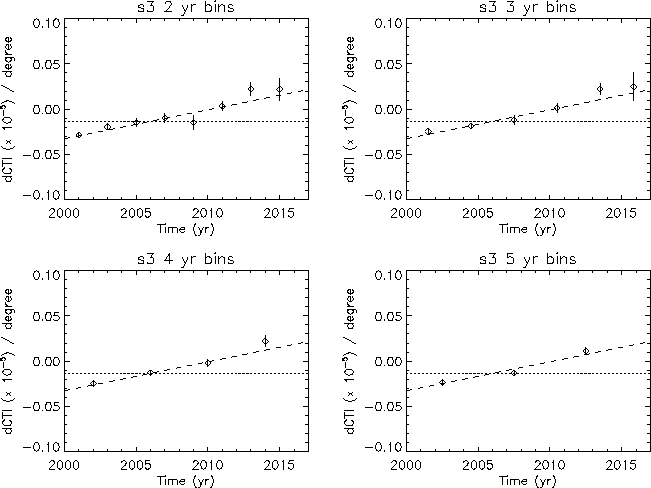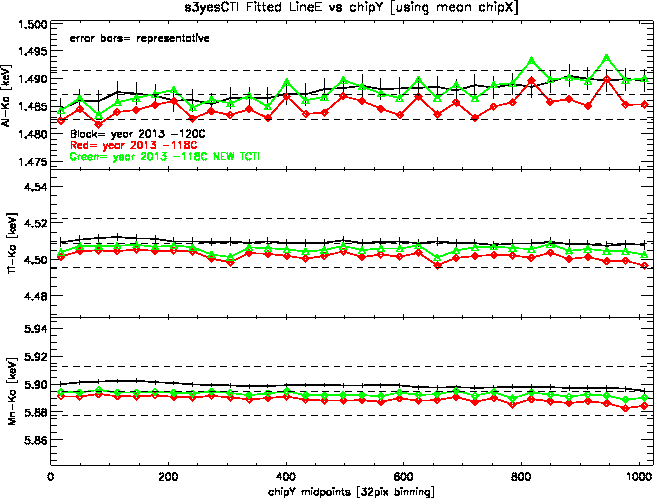CalDB 4.7.5 Public Release Notes
Released to the Public with CalDB 4.7.5.1 on 20 July 2017
SDP Installation Date: 2017-06-13T13:00:00 (UTC)
I. INTRODUCTION
CalDB 4.7.5 is an upgrade to the Chandra CalDB, which includes the following items:
For the CIAO 4.9 / CalDB 4.7.5 release notes see How CalDB 4.7.5 Affects Your Analysis.
II. SUMMARY OF CHANGES
A. ACIS-S3 time- and Temperature Dependent CTI Correction Files
| Location: | $CALDB/data/chandra/acis/cti/ |
| Filenames: | acisD2000-01-29ctiN0008.fits acisD2002-08-01ctiN0008.fits acisD2005-01-01ctiN0008.fits acisD2005-09-16ctiN0008.fits acisD2010-01-01ctiN0008.fits acisD2015-01-01ctiN0008.fits |
The ACIS Calibration team has released a sequence of time-dependent corrections to the Temperature-dependent CTI files for ACIS-S3 (CTI-corrected cases only). The calibration is derived from an essentially linear variation in d(CTI)/dT with time for S3. With the new calibration implemented, the CTI-corrected gain shift at higher focal plane temperatures is significantly reduced on ACIS-S3.
This new correction has been implemented using the CalDB time-dependence feature, wherein a series of CTI-correction files with staggered validity dates and differing values of the coefficient in question are installed in CalDB. Note: The CTI correction calibrations for the remaining chips remain unchanged in the new files.
NOTE: These changes only affect NON-GRADED MODE S3 observations, because the changes only affect S3 in CTI-corrected mode. There is no CTI correction for BI chips in the graded mode.
See the why page for basic information on the ACIS CTI corrections in ACIS Level 1 processing. For more details on the new calibration, please see the Technical Details section below.
PIPELINES/TOOLS AFFECTED:
For the ACIS Level 1 processing pipeline, the tool acis_process_events uses the CTI correction files when the parameter apply_cti is set to "yes".
For CIAO, the script chandra_repro also uses the CIAO-implemented version of acis_process_events, which uses the CTI correction files.
THREADS AFFECTED:
III. TECHNICAL DETAILS
A. ACIS-S3 time- and Temperature Dependent CTI Correction Files
The ACIS Cal team has been investigating the effectiveness of the temperature-dependent CTI correction installation introduced in standard processing with DS 8.3.3 and CalDB 4.4.0 in November 2010. After some detailed investigation, it has been found that there remains some secular variation of the gain corrections on the three ECS radiation lines with both temperature and mission time on all the ACIS chips. For the BI chips S1 and S3, the team discovered a more systematic variation that might (as a first attempt) be mitigated by introducing a linear (with time) variation in a single coefficient included in the first extension of the CTI-correction files. See Fig. 1 below for the variation in the S3 CTI with temperature derived by Catherine Grant (ACIS Cal Team), as of October 2016.

Fig. 1: Variation with mission time of the ACIS-S3 CTI per degree over the
life of the mission to date.
The dashed line is a linear fit to the data,
and is the same in all four plots.
A similar set of data were generated for ACIS-S1; however the implementation used for S3 does not work so well for S1, which as usual has a more complicated gain behavior with time and temperature. Hence the modifications for S1 require more effort, and will not be introduced here. For ACIS-S3, however, the CXC Science Sata System has implemented the above data in the TCTIY coefficients beginning with the existing N0007 CTI files in CalDB, to generate a set of five staggered CTI files now designated as version N0008.
As a test of the new calibration files, the ACIS team reduced and analyzed some ECS line-source data from several ACIS T_GAIN epochs, and at various focal plane temperatures, to determine how well the the ACIS-S3 modifications worked. The results for two temperatures (-120 and -118 C) and two periods (2000 and 2013) are shown in Figures 2 and 3 below, to give a simple illustration of the benefits of the new CTI corrections. The gain shift due to the higher temperature is stronger at lower energies, but is mitigated noticeably in all cases by the new calibrations.

Fig. 2: ACIS-S3 ECS line energy values versus CHIPY for three ECS lines from data
accumulated in the year 2000.
The black traces give the line energies for FP_TEMP=-120 C,
the nominal temperature of ACIS.
The red data are for -118C data with the previous
temperature-dependent CTI corrections applied (CTI version N0007).
The Green data show
are the same input data as the red, but with the new (N0008) CTI corrections applied.

Fig. 3: The same as Figure 2 above, but with with ECS data collected from year 2013.
As indicated by the figures, the new CTI corrections do reduce the systematic drift in the ACIS-S3 gains with time and temperature for all three of the ECS lines. Hence the Calibration team is releasing the new S3 calibrations in the following stepped values for the TCTIY coefficient in the CTI correction files.